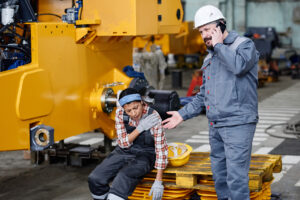Common Distribution Center Worker Injuries
Distribution centers are fast-paced environments with inherent risks that can lead to serious injuries and accidents. From forklifts and complex machinery to hazardous materials and environmental factors, warehouse workers regularly face numerous challenges. Forklift accidents, problems with machines, and the physical stress of lifting heavy things are all risks that need to be taken seriously.
Environmental factors such as slips, trips, and falls and impact injuries from falling objects can also pose significant risks. Mental stress and fatigue can further contribute to workplace accidents. Employers must prioritize safety protocols, regular training, and proper equipment to minimize these risks. Distribution centers face numerous safety risks that require practical solutions to enhance the safety and efficiency of all personnel.
If you’ve been injured while working in a distribution center, experienced workers’ compensation attorneys can help protect your rights and ensure you receive the benefits you deserve.
Distribution Centers High-Risk Workplace Hazards
 Distribution centers often face dangerous hazards that can lead to accidents and injuries. Forklift accidents are a common threat, as operators may not see pedestrians or be involved in collisions with racking systems. Mechanical equipment also presents dangers, with faulty machinery causing malfunctions that can lead to severe accidents.
Distribution centers often face dangerous hazards that can lead to accidents and injuries. Forklift accidents are a common threat, as operators may not see pedestrians or be involved in collisions with racking systems. Mechanical equipment also presents dangers, with faulty machinery causing malfunctions that can lead to severe accidents.
Warehouse workers regularly operate complex machinery like conveyor belts and automated systems. These machines can malfunction or be difficult to operate safely, leading to injuries. Proper safety training and clear operating procedures help prevent accidents and protect workers and equipment.
Common Injuries Among Distribution Center Workers
Physical Strain and Overexertion Injuries
 In distribution centers, physical strain and overexertion injuries are significant concerns. Lifting and handling heavy loads can lead to back, shoulder, and joint injuries, especially when improper techniques are used. Repetitive tasks like lifting, bending, or twisting can cause stress injuries like tendinitis and muscle strain.
In distribution centers, physical strain and overexertion injuries are significant concerns. Lifting and handling heavy loads can lead to back, shoulder, and joint injuries, especially when improper techniques are used. Repetitive tasks like lifting, bending, or twisting can cause stress injuries like tendinitis and muscle strain.
Ergonomic workplace challenges, such as poorly designed workstations or improper tools, exacerbate these risks by forcing warehouse workers into awkward postures. Proper lifting techniques and ergonomic workspace evaluations are important for preventing these injuries.. Providing regular training on safe lifting methods and making sure workstations are set up correctly can greatly lower the chances of physical strain and enhance the well-being of employees.
Environmental and Movement-Related Injuries
Injuries related to the environment and movement are common, as warehouse workers can easily slip, trip, or fall due to wet floors, messy walkways, or uneven surfaces. Dangers at loading docks, such as uneven ground, problems with dock levelers, or moving vehicles, add more risks for employees.
Congested workspaces, with narrow aisles or disorganized inventory, can make movement difficult and increase the likelihood of accidents. To prevent these injuries, maintain clear pathways, ensure proper housekeeping, and immediately report any potential safety hazards. Regular inspections and a proactive approach to safety can reduce the risk of environmental and movement-related injuries, keeping workers safe and operations efficient.
Impact and Compression Injuries
Being struck by falling objects, such as boxes or equipment from shelves, can cause severe head, neck, or limb injuries. Warehouse workers can also be caught between equipment or machinery, leading to crushing injuries, particularly in tight or poorly maintained areas.
Unexpected movements, such as the sudden start or stop of machinery or vehicles, further heighten the risk of these types of injuries. To mitigate these dangers, workers must always wear appropriate personal protective equipment (PPE), such as hard hats, gloves, and steel-toed boots. PPE helps protect against impact and compression injuries, creating a safer working environment for all employees.
Chemical and Hazardous Material Exposures
Chemical and hazardous materials can be particularly dangerous in distribution centers, especially when dealing with cleaning products, solvents, or industrial chemicals. Workers might breathe in toxic fumes, deal with spills, or come into direct contact with harmful substances, which can cause serious injuries right away or health problems down the line. If these materials aren’t handled properly — like not being labeled correctly or stored safely — it increases the chances of accidents.
Prolonged exposure to certain chemicals can eventually cause respiratory issues, skin burns, or even neurological damage. Strict safety protocols must be followed, including proper labeling, storage, and disposal procedures to reduce these risks. Workers must also always wear protective equipment, such as gloves, goggles, and respirators. Following these safety rules helps create a safer workplace for everyone.
Psychological and Stress-Related Workplace Challenges
Psychological and stress-related challenges are prevalent in distribution centers, where high-pressure work environments often lead to mental and physical strain. Tight deadlines, demanding quotas, and extended 12-hour work shifts can push employees to their limits, significantly increasing fatigue and accident risks. The fast pace of operations can cause employees to experience significant stress, affecting their well-being and job performance. Fatigue, often a result of long hours or insufficient rest, heightens the risk of accidents and errors.
Stress-induced performance issues, such as decreased concentration or poor decision-making, further contribute to workplace risks. It’s vital to recognize and address these stressors by fostering a supportive environment that encourages open communication and offers mental health resources. Employers should implement policies that promote adequate rest, stress management techniques, and employee well-being programs. Proactively addressing workplace stress can improve productivity and safety, creating a healthier, more efficient work environment.
Legal Protections and Workers’ Compensation
 Workers’ compensation can help safeguard employees who get hurt while working, making sure they have access to medical treatment and can replace lost wages. These claims can cover a variety of injuries, including physical accidents and issues related to stress. For those with long-term disabilities, financial disability benefits are available to help if they can’t return to their jobs.
Workers’ compensation can help safeguard employees who get hurt while working, making sure they have access to medical treatment and can replace lost wages. These claims can cover a variety of injuries, including physical accidents and issues related to stress. For those with long-term disabilities, financial disability benefits are available to help if they can’t return to their jobs.
If employees struggle to get the compensation they deserve or face negligence from their employers, they have legal options. They can take legal action against denied claims, unsafe work conditions, or inadequate compensation. Workers need to know their rights and how the compensation process works.
Understanding your workers’ compensation rights is essential after a workplace injury. For 65 years, Munley Law’s workers’ compensation attorneys have helped injured workers navigate the complex legal system, winning significant settlements and securing the benefits their clients need to protect their health and financial security. Call Munley Law today for a free consultation about your case.

Marion Munley
Marion Munley is recognized for her compassionate representation of catastrophically injured clients and her steadfast dedication to them and their families. Her advocacy has produced numerous multimillion-dollar recoveries, including one of the largest trucking accident settlements on record. Marion is Triple Board Certified by the National Board of Trial Advocacy in Civil Trial, Civil Practice, and Truck Law, and since 2023 has been named one of Pennsylvania’s Top 10 Super Lawyers by Super Lawyers.
Posted in Workers' Compensation.
Tagged Negligence









